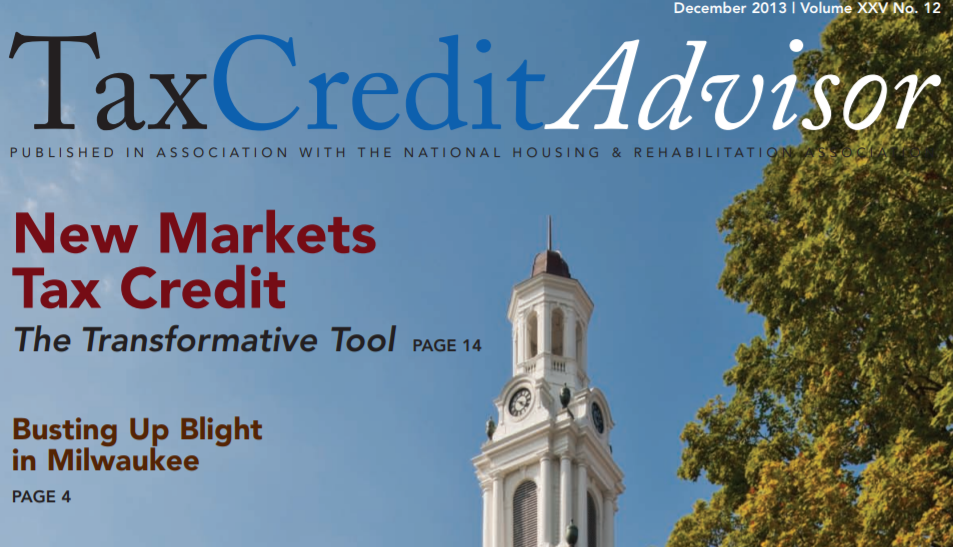A Better Mousetrap
This article was originally published in the Tax Credit Advisor, December 2013.
Different Model Opens Access to NMTC Financing for Smaller Projects
Through the creation of a different structuring model, Smith NMTC Associates, LLC (SNMTC) is making it possible for smaller projects to gain access to new markets tax credit (NMTC) financing by reducing initial and ongoing transaction costs. This “open capitalization” model can be used to fund qualified low-income community investments (QLICIs) as small as $500,000, rather than the usual industry minimum of $5 million.
SNMTC’s founders, Donna and Howard Smith, have used this model in multiple transactions providing over 50 Habitat for Humanity affiliates with additional funding to build affordable for-sale homes. But the same model can be adapted for other types of NMTC projects and qualified active low-income community businesses (QALICBs).
SNMTC refined its model over a series of 22 transactions funding $278 million in NMTC projects in partnership with U.S. Bancorp Community Development Corporation, Novogradac & Company LLP, Polsinelli Shughart, Husch Blackwell, and Elkins PC. Seven of these transactions ($103 million) used a NMTC allocation from a community
development entity (CDE) of which SNMTC is part owner. Twelve other CDEs provided allocations for the remaining 15 transactions ($175 million). SNMTC sources and facilitates all transactions and acts as the guarantor of the QALICB recapture risk to the investor and as the “back office” for the QALICBs to help them with the seven years of compliance required by the NMTC program. These roles are often the key ingredient allowing smaller QALICBs with minimal staff and resources to participate in NMTC transactions.
Details of Model
The open capitalization model combines multiple, smaller QALICBs in one transaction, allowing them to share closing costs and ongoing expenses rather than bear these costs alone. Typical costs for an NMTC transaction include: CDE fees, CDE audit and tax fees, investment fund fees, leverage lender costs, closing costs (includes attorney fees), and loan servicing fees throughout the seven-year compliance period. Together, these costs typically exceed $1 million in any single transaction, regardless of its size. By contrast, using the model, SNMTC has reduced the transaction costs borne by any one QALICB from more than $1 million to just under $90,000 – a savings of over 90%.
For example, SNMTC combined 12 QALICBs and 12 QLICIs in a single $28 million NMTC deal. Using the model, the QLICIs were closed in three separate tranches on a successive basis over a six-month period, using just one leverage lender, one investment fund, and one sub-CDE. In each tranche, the leverage lender operating agreement was amended and restated to admit new Habitat affiliates whose resulting diluted interests were proportionate in size to their interest in the aggregated QLICIs. The leverage lender counsel is the manager with the authority to accept the “put” or exercise the “call” from or to the investment fund at the end of the compliance period.
The investment fund and sub-CDE operating agreements were drafted to accept additional capitalization through amendment and restatement. The schedules were aggregated so that the successive tranches reflected the total funding of fees, reserves, and benefits. Using the open capitalization model resulted in each QALICB bearing roughly $90,000 in total costs, rather than $1 million in costs if they had participated in an individual NMTC transaction.
Using this model, SNMTC, in partnership with USBCDC and 12 other CDEs, has provided $278 million of financing in support of the construction, financing, and sale of Habitat homes across the nation. This translates into 3,049 homes for needy families while revitalizing low-income communities in 30 states and creating almost 5,000 construction jobs and creating/retaining over 2,000 permanent jobs.
Applicable Model
This open capitalization model can be applied to other NMTC transactions and other QALICBs. It would work best with QALICBs that share similar business models, or QALICBs located in the same development or the same geographic area because these QALICBs will jointly own the leverage lender. As members of the leverage lender, they will need to agree before the deal closes on how the put/call option will be exercised to wind up the deal at the end of the compliance period. QALICBs that share similar business models or are otherwise committed to development in the same area will more readily adapt to a joint leverage lender ownership model. All participating
QALICBs will achieve significant savings using this model. QALICBs with similar business models can achieve additional savings on legal fees because the documentation can be streamlined and replicated for those QALICBs, regardless of where they are located (similar to the Habitat affiliates). QALICBs with different business models in the same area will also see legal cost savings because only one state’s laws are involved. To maximize the cost savings, the closings should occur within a 12-month period to eliminate extra costs caused by the different schedules in amortization, loan servicing, and put/call option periods.
Smaller projects (QLICIs as small as $500,000) can now use NMTCs to help fund their projects through use of the open capitalization model. It may take a little more work to find the right partner QALICBs, but the savings achieved make it worth the effort. With lower transaction costs, more QALICBs can access capital, and more low-income communities and their residents will benefit.

